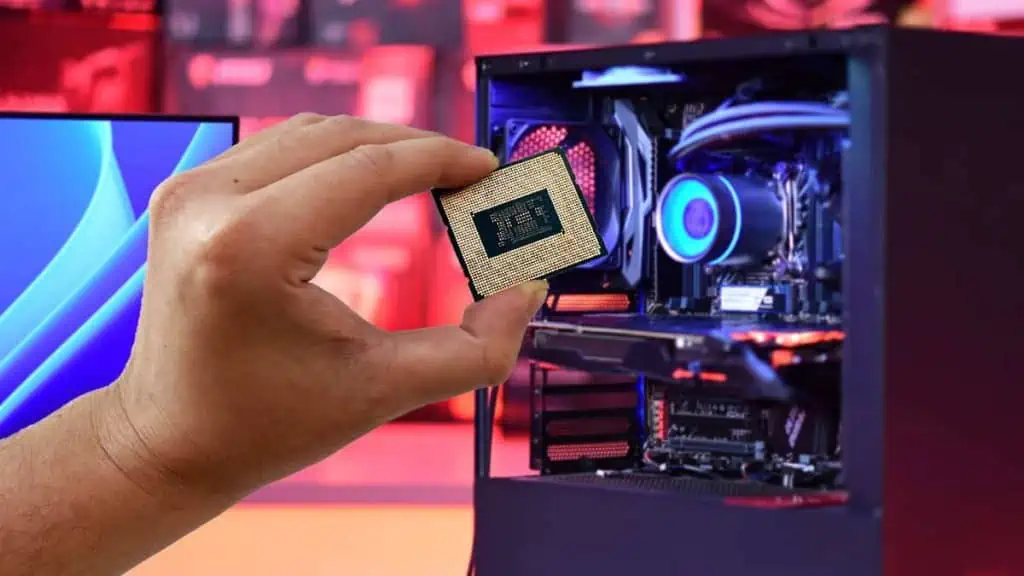Choosing a CPU is all about finding the perfect balance between your budget and needs. You definitely wouldn’t want to compromise performance just for a slight difference in price.
It’s essential to understand the basic processor specifications, at the least. Generation, clock speed, cores, threads, cache, and TDP all play crucial roles in determining CPU performance.
Along with that, getting to know the memory and graphics support is also important. Only then should you consider what RAID levels, USB versions, PCIe lanes, and other features the processor supports.
When choosing a CPU that has the best price-to-performance ratio, it mainly depends on what you’re going to do.
Here are my general recommendations on the processor specs that would be ideal for the specified tasks:
| Specifications | General Use | Multitasking | General Gaming | Heavy Gaming and Streaming | For Enthusiasts |
| Cores / Threads | 2 to 4 / 2 to 4 | 4 to 8 / 8 to 12 | 2 to 6 / 2 to 8 | 4 to 8 / 4 to 8 | 8 and higher / 12 and higher |
| Clock Speed (in GHz) | 1.3 to 2.0 | 2.0 to 3.2 | 3.2 or higher | 3.7 and higher | 3.7 and higher |
| TDP (in Watt) | 35 to 65 | 65 to 95 | 65 to 95 | 75 and higher | 90 and higher |
| L3 Cache (in MB) | 4 to 8 | 8 to 12 | 8 to 16 | 16 to 24 | 24 and higher |
| Memory (DDR Type/Speed/Size) | DDR4 (Upto 2400), 4 GB | DDR4 (Upto 3200), 8 GB | DDR4 (Upto 3200), 8 GB | DDR4 (Upto 4266), 16 GB | DDR 4 (up to 4266) or DDR5, 16 GB or more |
| Graphics | Integrated Graphics | Integrated Graphics | Add a dedicated GPU | Add a dedicated GPU | Add a dedicated GPU |
First, Understand Your Needs
The first question is—are you building a new PC or just trying to upgrade to the latest CPU generation?
Your option is further narrowed if you’re already equipped with a motherboard. The processor you choose should be compatible with all the other components—primarily the motherboard.
But if it’s the other way around, choosing the appropriate CPU is the first thing to do. Based on this choice, you now need to shop for other compatible components (motherboard, RAM, graphics card, etc.).
The next question is—what are you going to do with your rig? Gaming, streaming, multi-tasking, editing, or a combination of these tasks? You’ll likely find a range of products that matches your demand.
Take a quick peek at the below chart on how I have chosen the best processor for different builds.
| Purpose | CPU | Motherboard |
| General Use at Home (For Budget) | Intel Core i3-10100F | ASUS PRIME B560-PLUS |
| Office Use (Intense Multi-tasking and Editing) | Ryzen 7 5700G | MSI MAG B550M MORTAR |
| Main Home PC (Gaming, Streaming, and Rendering) | Intel Core i5 12600K | ASUS ROG STRIX B760-A GAMING WIFI |
As you can see, there’s no compulsion in choosing the most recent CPU. If it satisfies your demands and comes at the planned budget, you may go for it!
However, if you’re looking to build a server or workstation, there are dedicated CPUs for that as well. For instance, Intel offers Xeon processors and AMDs have Threadrippers.
Also, there are AMD Athlon, Intel Celeron, and Intel Pentium processors. All are popular among budget users but are comparatively slower than Ryzen and Core.
Compatibility With Motherboard
Your processor must fit perfectly into the respective motherboard slot/socket. If you choose one that’s incompatible, it won’t get sufficient power to operate.
In fact, there’s a chance you may damage/bend the pins during the CPU installation.
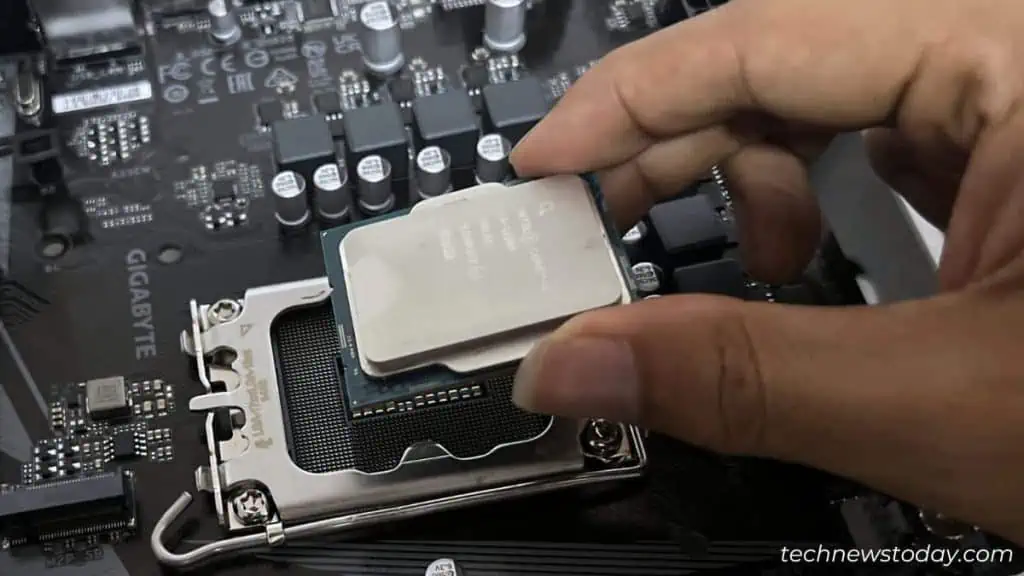
The thing is—custom PC build isn’t just about fitting the components to the right place. It’s more about compatibility! That’s the reason I recommend purchasing the motherboard and CPU together.
Firstly, understand that there are two socket types. LGA (Land Grid Array) indicates pins in the motherboard, while PGA (Pin Grid Array) refers to pins in the CPU.
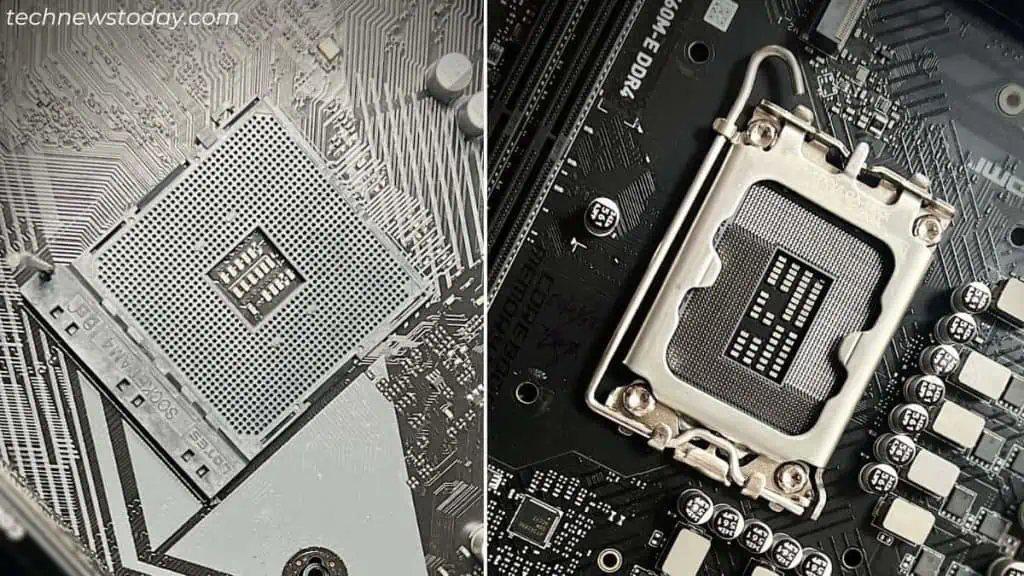
Almost all Intel processors follow LGA packaging while a majority of AMD sockets are PGA.
Picking the right brand is a separate topic in itself. Just understand that manufacturers design different motherboards for Intel and AMD.
The CPU sockets have a naming convention. Understanding this will give you an idea of which processor can fit into your motherboard.
For example, most Alder Lake (12th Gen) and Raptor Lake (13th and 14th Gen) go with LGA1700 sockets. So, you need to pair an appropriate LGA1700 motherboard. Note that only a handful of motherboard chipsets support the latest processors.
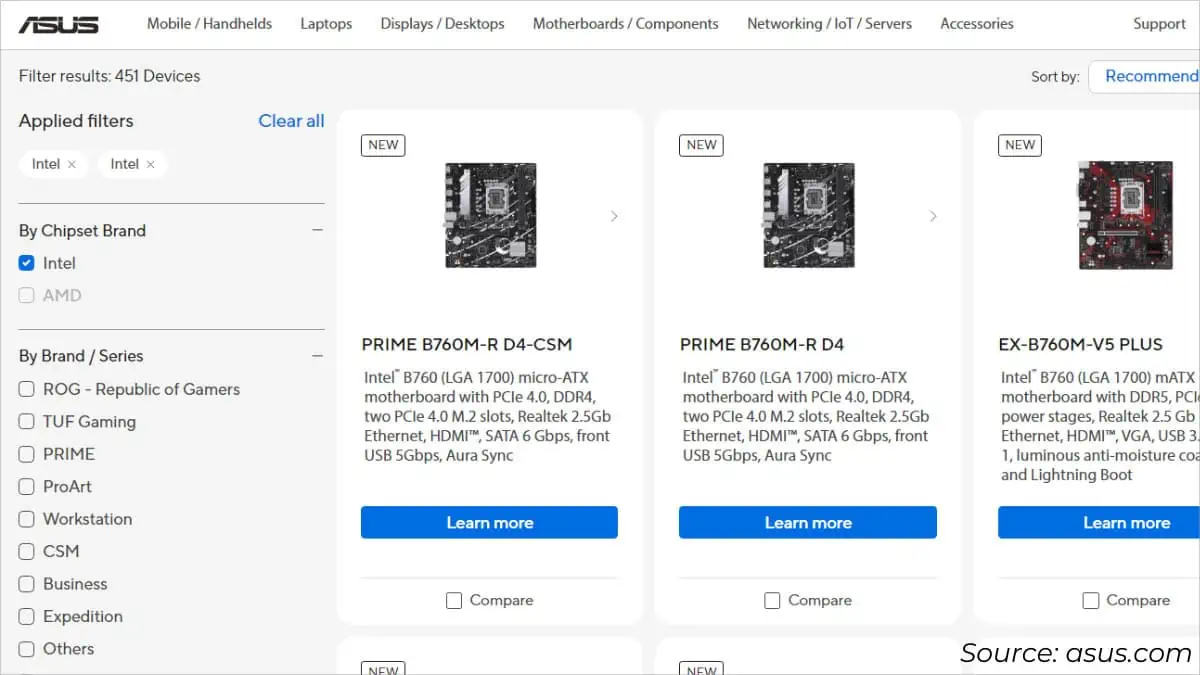
When shopping for a motherboard, I always check the manufacturer’s Product Catalog page online.
But if you’re trying to upgrade the CPU in the existing system, you’ll likely find CPU/Memory in the model’s Support section.
Since the listed products are properly tested, you may choose one that best satisfies your demands.
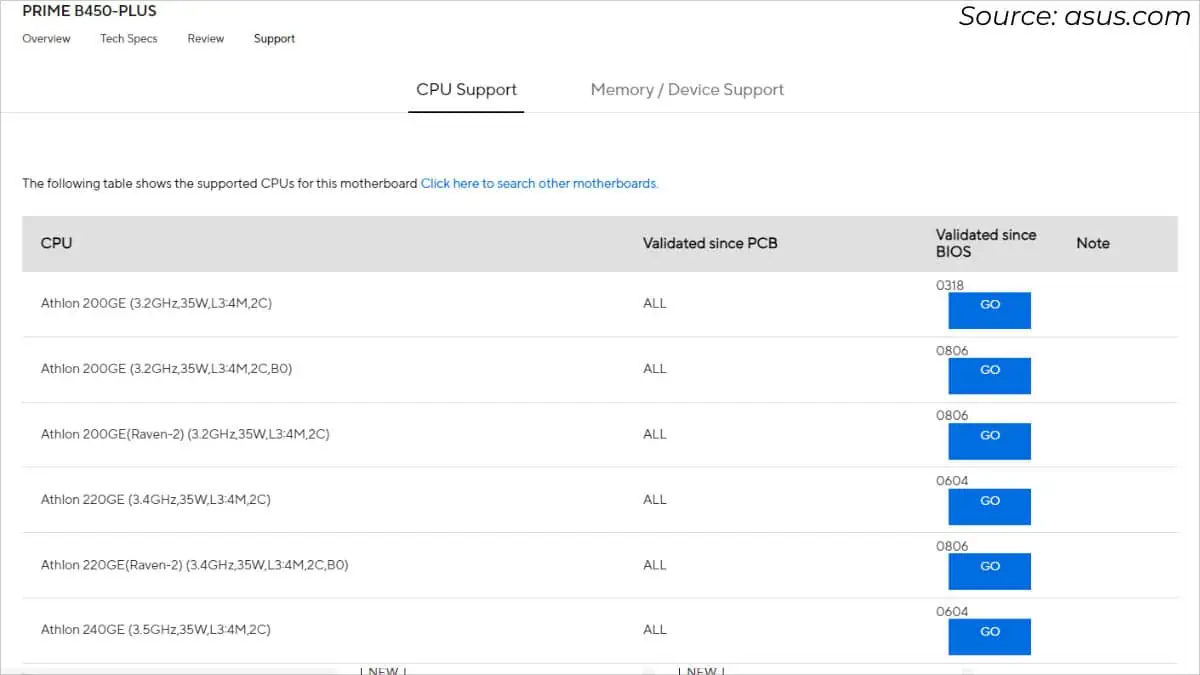
Beginners may even get help from online utilities. Sites like PCPartPicker, PC Builder, and PCspecs let you choose compatible components in a matter of seconds!
Check General Specifications
Before purchasing any product, I advise developing a habit of checking the specifications.
The same goes for the CPU—this doesn’t just determine the compatibility but even its performance capabilities.
Depending on what processor brand you’re going for, you can inspect the official website for full specifications. Don’t worry even if you don’t know what they mean.
I’ll briefly explain the most basic ones here.
Platform
AMD Ryzen and Intel Core aren’t just available for desktops. These companies produce CPUs for laptops and mobile devices too.
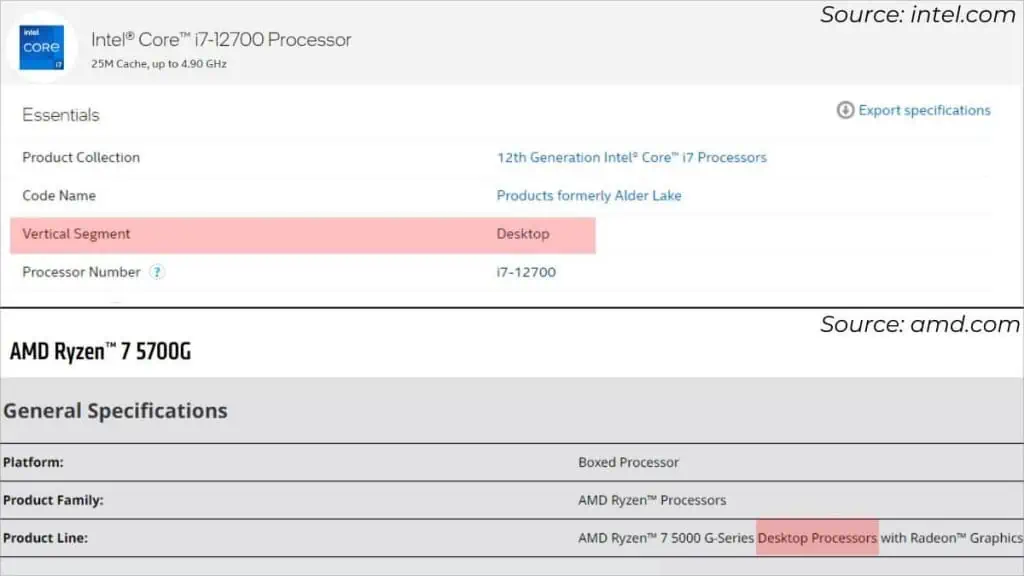
For AMD, inspect the Product Line field, and for Intel, look for Vertical Segment. They clearly tell you whether the CPU you’ve chosen is for desktop use.
Suffix
Understanding the naming scheme gives you an additional idea when shopping for the right CPU.
The suffix in the product model specifies whether a processor supports integrated graphics, has unlocked cores, is power-optimized, etc.
For example, G series AMD processors are called APUs (Accelerated Processing Units) as they come with graphics cores.
Likewise, Intel’s K and F series are the most common. K are unlocked CPUs, while F doesn’t support integrated graphics.
| Brand | Suffix | Meaning |
| Intel | F | No iGPU support |
| K | Unlocked multipliers (best for overclocking) | |
| S | Special processors optimized for performance | |
| T | Optimized for power | |
| X, XE | For extreme performance (better than the K and S series) | |
| B | Processors supporting Ball Grid Array (BGA) sockets | |
| G1-G7, HX, HK, H, P, U, Y, E, UE, HE, UL, HL | CPUs for Mobile/Laptops/2-in-1s/Embedded systems | |
| AMD | G | Supported Integrated Radeon Graphics |
| GE | Radeon Graphics + Energy Efficient | |
| X | Better than the base version (for example, 2600X > 2600) | |
| X3D | Processors supporting 3D caching technology |
Cores, Threads, and Clock Speed
All modern processors have multiple cores and threads. The question is—how many are required for you, and should it necessarily be higher?
As a content creator myself, I would say YES—they are important! On my dual monitor setup, I’m always multi-tasking, which involves rendering, writing, editing, running tests, and designing.
This is only possible with a high number of cores and threads. So, for me, speed is secondary.
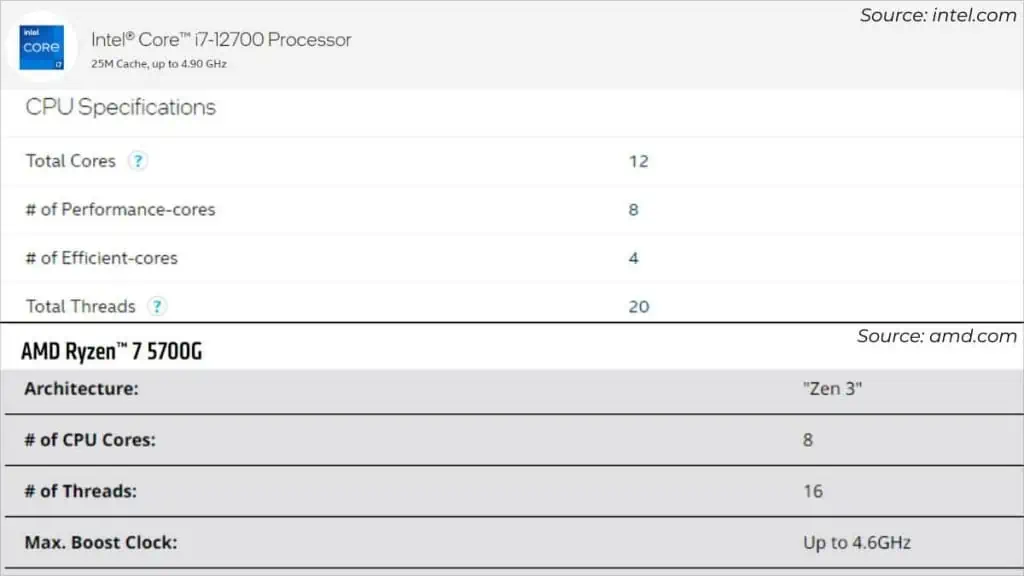
But if you only play games, these specifications do not matter so much! It would rather be a smart move to go for a higher clock speed.
In fact, for most older games, 2 to 4 cores are more than enough. However, fast-paced video games now take advantage of multiple cores, involving 6 to even 8.
Thus, it really depends on what you’re trying to play!
Moreover, the processor is responsible for basic tasks (mainly involving physics calculations, game logic, etc.). Therefore, it certainly can impact the FPS, especially when the games are CPU-intensive.
For extreme gamers, it’s essential that you pair your CPU with the best graphics card.
The chart below shows the benchmark scores (both single and multiple cores) of different Intel and AMD CPUs at our office. The higher the number, the better the expected performance.
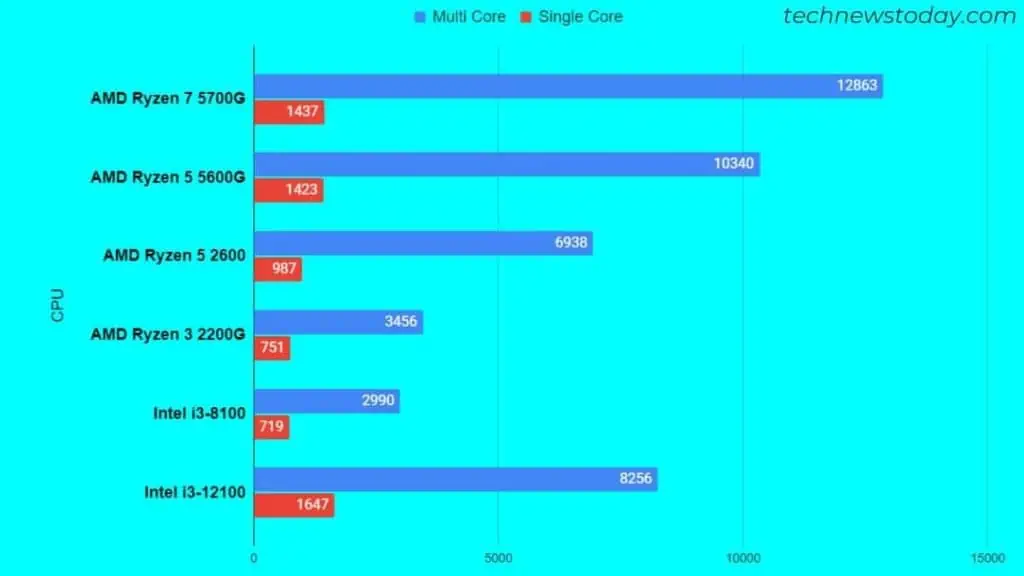
Thermal Design Power (TDP)
This specification tells us how much power a CPU may consume when it’s under the highest load.
Note that TDP is just a rough figure portrayed by the manufacturer and might not always relate to the real-world scenario.
Keep TDP as your baseline when purchasing the right cooler for your build. If the cooling solution can’t handle the power consumed by the CPU, you might end up damaging the chip.
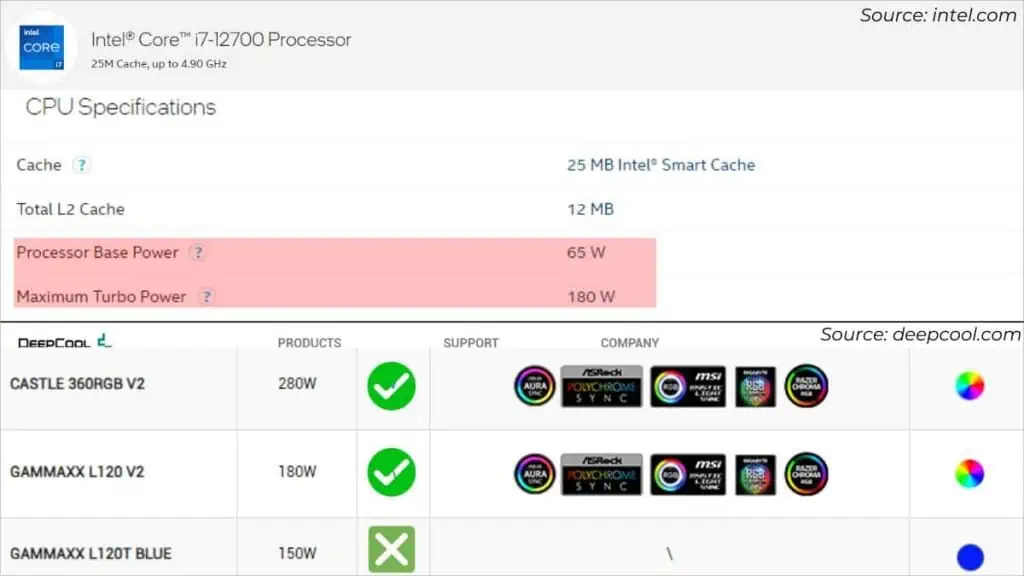
If you’re only going to use the processor for basic tasks, a lower TDP should suffice. But for gamers and enthusiasts, overheating is definitely a concern.
So, the best bet would be to go for a higher Watt along with sufficient cooling that matches the rated TDP.
AMD CPUs with the ‘X’ and ‘X3D’ suffixes are the ones with the highest TDP. Such processes do not get shipped with a Wraith Prism, which is often included with the ones having lower TDP.
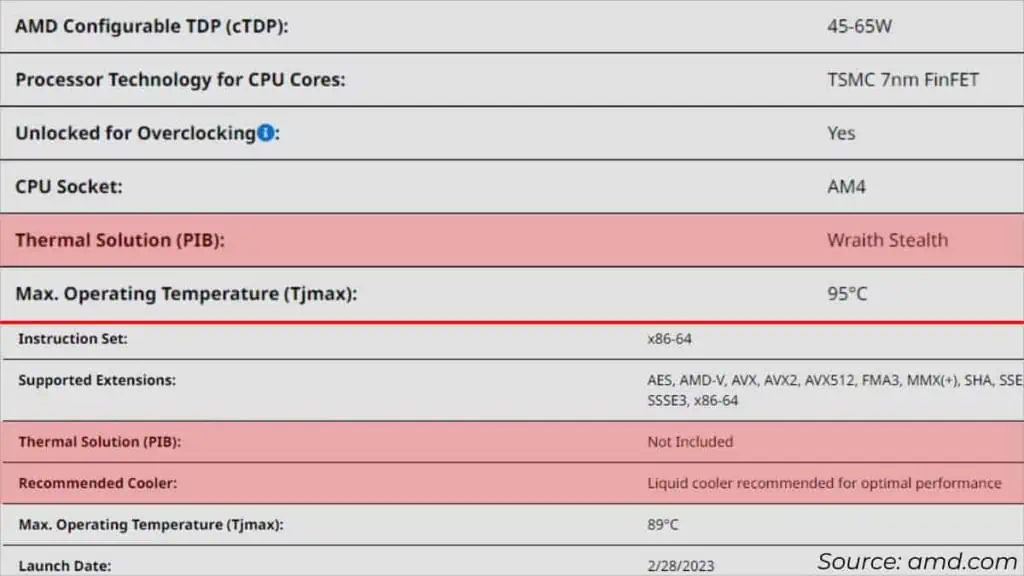
This is because even the manufacturer wants you to use the best liquid or air coolers. Interestingly, this is even included in the CPU specifications.
Not all lntel processors provide the exact TDP rating. Instead, you need to look for Processor Base Power and Maximum Turbo Power.
The former tells you the average heat generation during complex workloads (at the base frequency). The latter represents the heat generation when the CPU runs in Turbo Frequency.
Additional Tip: When performing intensive tasks or overclocking, CPU temperature can rise more than expected. To keep a baseline, I suggest noting the maximum temperature from the Specifications.
Total Cache
Not all processors access data from the RAM. CPU stores some of these in their own volatile cache memory to execute tasks faster.
There are three levels of cache (namely, L1, L2, and L3). Among these, the first level is the fastest, and the third has the highest capacity.
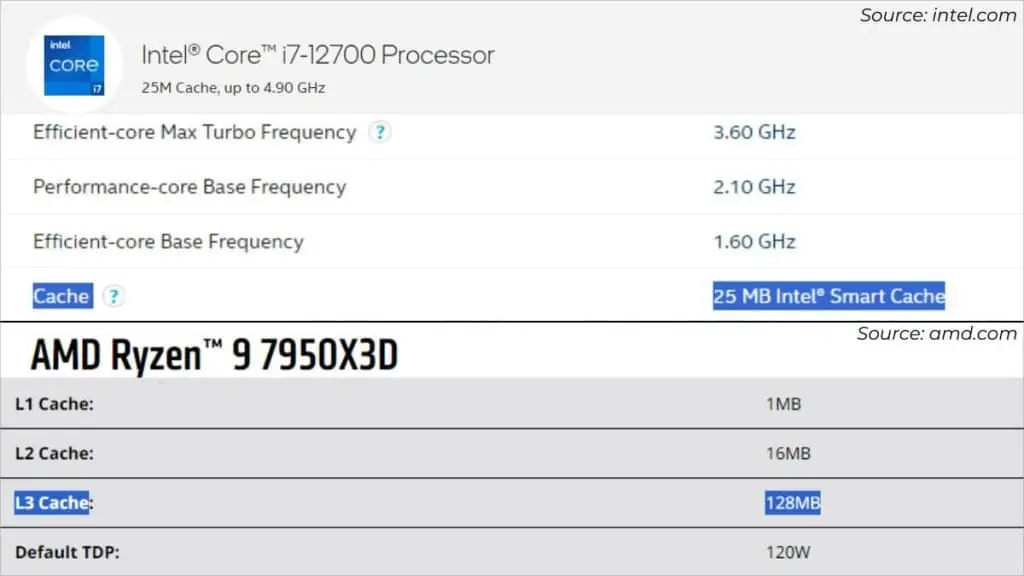
The more the CPU can store data in the cache, the better the performance. The latest processors now come with 32 to even 128 MB L3 cache capacity.
So, your primary focus should be on L3. In fact, this level is shared by every CPU core and is responsible for feeding the other two.
Memory Support
Whether you want to run multiple memory channels or future-proof your rig with DDR5 support, the CPU must support them.
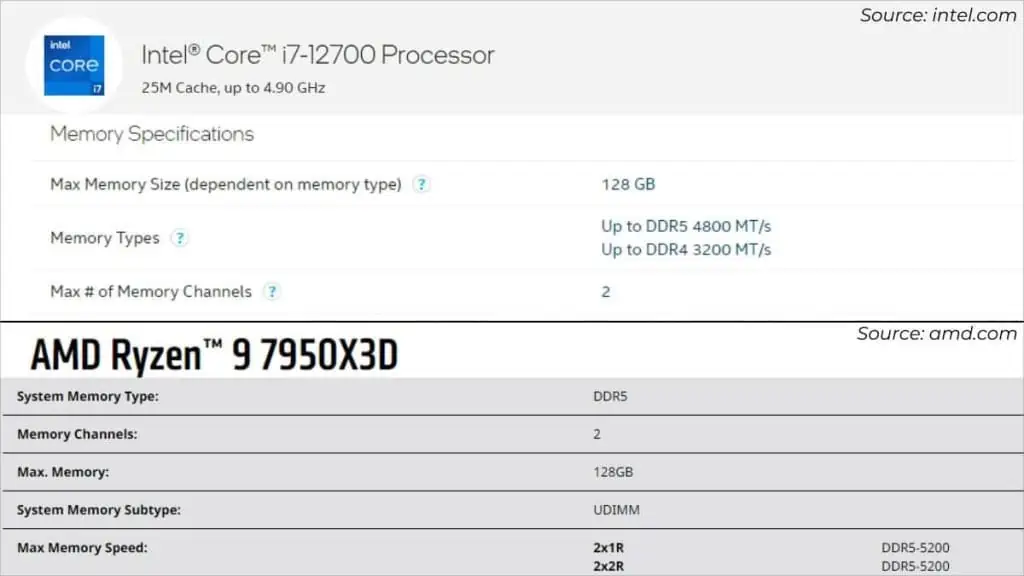
Besides, other factors, including maximum memory capacity, RAM speed, and ECC support are also determined by the processor.
Understand Generation and Brand Modifier
Both Intel Core and AMD Ryzen bring improvements to every new generation. Thus, you can expect better performance, more cores, and overall better specs on their latest CPUs.
Going for the brand modifier wouldn’t be a bad idea when comparing CPUs from the same generation.
For instance, every desktop CPU from Intel Core i9 12th gen will outperform those from the i7 12th gen.
But what if we compare a lower generation from a higher Intel Core with a higher generation from a lower one?
Let’s see the difference below:
| CPU | Cores/Threads | Base/Max Frequency | TDP | Max. Memory Support |
| i9-9900K (discontinued, only taken here for example) | 8/16 | 3.6/5.0 GHz | 95 W | DDR4 2666 MT/s |
| i7-10700K | 8/16 | 3.8/5.10 GHz | 125 W | DDR4 2933 MT/s |
| i5-11500T | 6/12 | 1.5/3.9 GHz | 35 W | DDR4 3200 MT/s |
| i3-12100 | 4/8 | 3.3/4.3 GHz | 60 W base and 89 W max | DDR5 4800 and DDR4 3200 MT/s |
The CPUs from the i9 and i7 have the better specs despite the lower generation. But it’s worth mentioning that the 10th-gen i7 processor slightly beats the 9th-gen i9 in every aspect.
However, the CPU generation matters if you’re planning for better RAM specifications.
As you can see, the high-generation i5 and i3 support better memory speed. In fact, if you have a DDR5 motherboard, only the i2-12100 would be your option.
The case is identical for Team Red users. Let’s check the comparison on Ryzen 7 and 5 AMD CPUs from different series:
| CPU | Cores/Threads | Base/Max Frequency | Max. Memory Support |
| Ryzen 7 2700 | 8/16 | 3.2/4.1 GHz | DDR4 2933 MT/s |
| Ryzen 7 4700G | 8/16 | 3.6/4.4 GHz | DDR4 3200 MT.s |
| Ryzen 7 5700G | 8/16 | 3.8/4.6 GHz | DDR4 3200 MT/s |
| Ryzen 7 7700 | 8/16 | 4.5/5.4 GHz | DDR5 5200 MT/s |
| Ryzen 5 2600 | 6/12 | 3.4/3.9 GHz | DDR4 2933 MT/s |
| Ryzen 5 4600G | 6/12 | 3.7/4.2 GHz | DDR4 3200 MT/s |
| Ryzen 5 5600G | 6/12 | 3.9/4.4 GHz | DDR4 3200 MT/s |
| Ryzen 5 7600 | 6/12 | 3.8/5.1 GHz | DDR5 5200 MT/s |
You can clearly see that Ryzen 7 beats Ryzen 5 in terms of number of cores and threads. But when it comes to speed and memory specs, the higher the generation, the better.
For instance, the 7000 series from Ryzen 5 is way ahead of 2nd gen Ryzen 7.
Integrated Graphics and PCIe Support
‘Integrated graphics’ is another important thing to consider when choosing a CPU. As discussed earlier, most Intel processors (except the F suffix) and AMD APUs support built-in GPUs.
It’s mostly the ones with the ‘G’ suffix for Team Red. However, there are exceptions!
For instance, all Ryzen 7000 series (except Ryzen 5 7500F) have graphics cores in the processor chip.
You certainly can add a discrete graphics card and disable the iGPU option from BIOS.
But if you’re really planning to install a GPU, it’s better to pick the base variant (for basic use) or the one with the ‘X’ suffix (for enthusiasts).
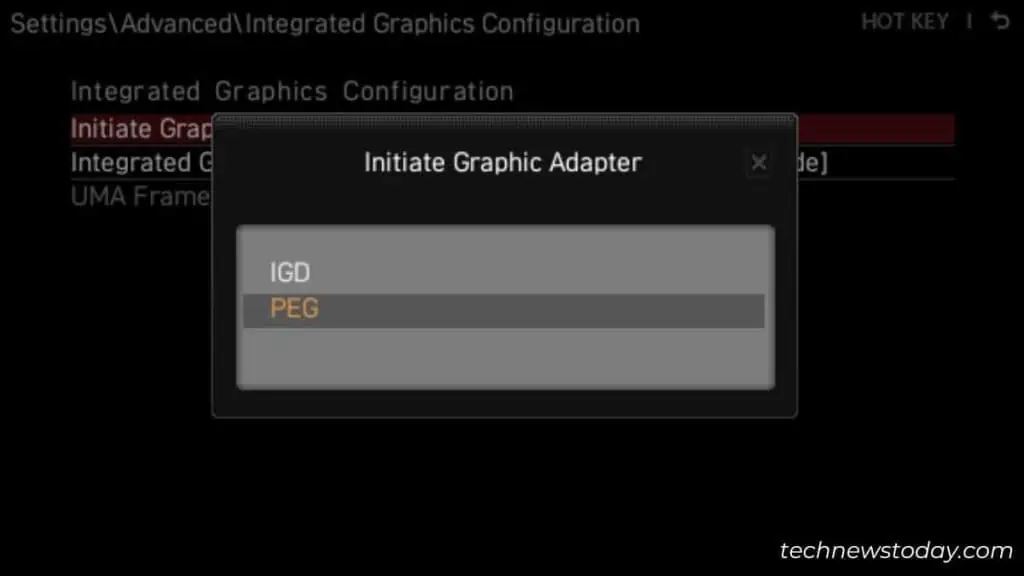
When looking for the best CPU with integrated graphics, it’s essential to consider the relevant graphics specs. These include core counts, frequency, number of displays supported, etc.
Also, here’s a guide to help you choose the best motherboard with integrated graphics.
Users who plan to install an add-on card along with an M.2 SSD are advised to choose a CPU that supports enough usable PCIe lanes.
Also, to get the maximum benefits, I suggest matching the PCIe version (2.0, 3.0, 4.0, or 5.0).
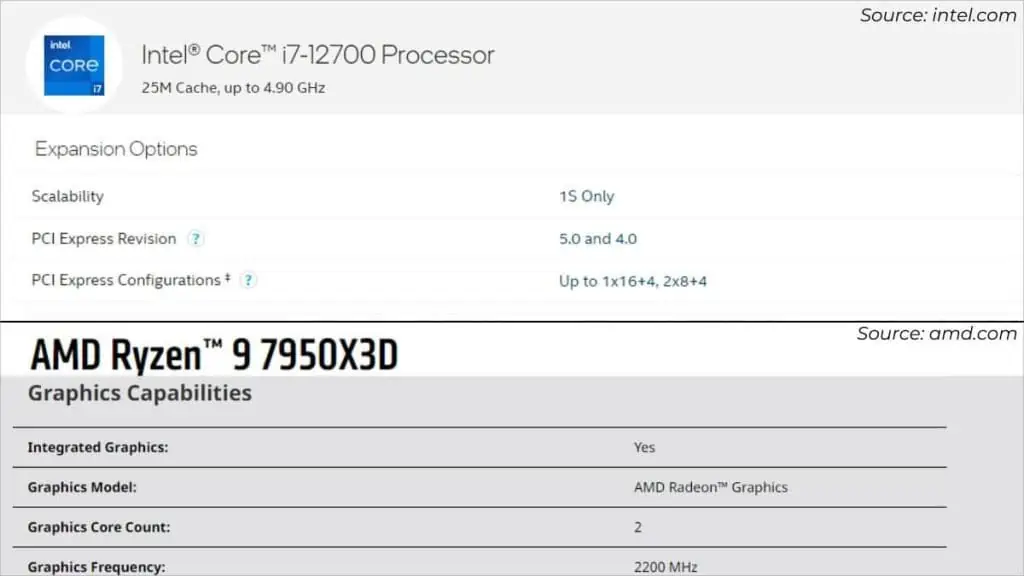
Don’t get too stressed about this, though! All PCIe revisions are forward and backward-compatible.
The setup will work but use the lowest specs and may even lead to performance bottlenecks.
That’s exactly what happened to us when pairing RTX 4080 with Ryzen 5 5600. We couldn’t get the benefits of PCIe 4.0 as the graphics card ran at the CPU-supported PCIe 3.0 specs.
Additional Features and Future Proofing
While most factors have now been covered, there might be additional features you might want to look up. These include support for advanced technologies, like,
- AMD Precision Boost, AMD EXPO Technology
- Intel Adaptive Boost, Intel Turbo Boost, Intel Boot Guard
- Virtualization (Intel VT-x/VT-d and AMD-V)
- OS support
- USB types (A or C) and versions (especially 3.0, 3.1, and 3.2 support)
- RAID support
- Maximum resolution (for HDMI and DisplayPort)
- DirectX / OpenGL / OpenCL support, etc.
These features are actually secondary. What matters is future-proofing.
If you do not wish to upgrade your build for the next few years, I suggest going for the latest CPU.
Amidst the popularity of crypto trading, we have got you covered with the best CPUs for crypto mining. For such, you’ll need to go for high specs—more cores and threads, faster speed, higher TDPs, and better cooling.
Research, Compare, and Find Deals
Considering the latest generation, the number of cores, threads, power delivery, and total cache are all important.
But as I stated earlier, it comes down to your needs—and most essentially if it fits into your budget.
Through this guide, I believe I have done the groundwork for you. Now, it’s your turn to compare the different CPUs through your own research.
For demonstration, I have compared i3-8100 with Ryzen 3 2200G for a budget build office setup:
| Specifications | Intel Core i3-8100 | Ryzen 3 2200G |
| Cores/Threads | 4/4 | 4/4 |
| Base Clock Speed | 3.6 GHz | 3.5 GHz |
| TDP | 65 W | 65 W |
| Cache | 6 MB | 4 MB |
| Memory | DDR4 2400 MT/s | DDR4 2933 MT/s |
| Graphics (Frequency) | 350 MHz | 1100 MHz |
| Benchmark Score (Single/ Multi Core) | 719 / 2990 | 751 / 3456 |
| Cost (Amazon) | $110.00 | $150.00 |
Here, Ryzen 3 has a slight edge over the Intel Core i3 processor. Specifically, the memory and graphics are much better. That’s probably why it scored higher during the benchmark using Cinebench R23.
The better one always costs more—and the above example shows it all. But here’s a surprise—we got this Ryzen CPU in the Black Friday deal (with 33% off).
So, you see, a smart move would be looking for such offers online. I am not recommending Amazon—you can find deals anywhere, even in the nearest brick-and-mortar stores.
And during your research, just don’t stick with one YouTube video or a guide from a single tech site.
Take your time and check reviews and benchmarks from multiple sources.
List down the pros and cons, and try to see how you can tackle the drawbacks that you find.

